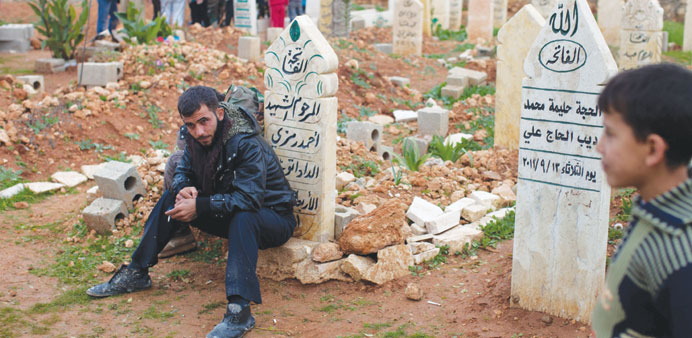By Yazan al-Homsy/Homs
|
I still remember April 18, 2011, when it seemed all of Homs turned out for the funeral of 12 people. Tens of thousands of men and youths exited the grand mosque of Homs, the coffins held aloft amid the multitudes. The procession headed to al-Kateeb cemetery, one of the most revered burial grounds for Muslims in the city. |
Twenty years ago, Homs residents were forbidden from burying their dead in al-Kateeb cemetery; it was running out of space and the final few places were reserved for only the most prominent sheikhs. They would be the lucky few accorded the honour of burial beside the companions of the Prophet Muhammad, who had been laid to rest in this very cemetery centuries earlier.
But these 12 people had given their life for their country and a historic exception was made. This was at the start of the Syrian revolution more than two and a half years ago – before it became a luxury to be able to bury your dead in a proper grave.
In the months following that solemn procession, opposition members were hunted down across the country by regime forces and the shabiha, or loyalist gunmen. Raids ended in torture or death, and the graveyards were soon overcrowded: they were unable to contain all of the bodies, or what was left of them. In Homs, only the Tal al-Nasr cemetery had space left to accommodate the dead.
Funeral processions once served as a rallying point for thousands of people to renew their pledge to topple the regime and follow the path of the revolution. The ceremony would start with a prayer at the neighbourhood mosque, and then attendees would carry the coffins to the cemetery and bid the fallen their final farewell.
All of that changed when a funeral procession was infiltrated by the shabiha and ended in the killing of 17 people, with dozens of others missing. That would be the last public procession.
Today, funerals can only include two attendees: one family member and a gravedigger. In place of a mass demonstration, a small gathering is held in the person’s neighbourhood, during which attendees promise to follow in the deceased’s footsteps. Despite all these precautions, funeral hearses are still targeted at regime checkpoints. This made it impossible to transport anyone to the Tal al-Nasr cemetery.
The difficulty of holding a proper funeral is felt no more strongly than it is in the 14 besieged neighbourhoods of Homs, where a total blockade has affected the living and the dead.
Funerals have become brief affairs, with no more than a handful of attendees. Graves must be dug manually, and even those moments spent digging are a risk; burial areas are sometimes targeted by army bombardments, compounding the average risk of getting hit by random daily shelling.
One thousand people were buried in the first year of the siege alone. Now the death toll increases every day, along with the need for burial grounds.
The best solution was to convert some mosque yards and later, two public parks, into cemeteries. When these areas were full, residents began burying the dead among the living, next to peoples’ homes.
Sometimes, the ferocity of the bombardments take away any need or hope for burial. Attempts to retrieve the dead are futile when the army drops TNT-laden barrel bombs or fires surface-to-surface missiles, capable of levelling four-story buildings. Their bodies are left where they have fallen to decompose.
For families divided on opposite sides of the siege, there is no way to see a loved one for the last time. There are no humanitarian exceptions for bodies to be transported out, and so many are laid to rest without a relative in attendance.
“You might not find anyone to bury you,” is a phrase commonly heard among residents living under siege. The situation is deteriorating amid consecutive military operations to overrun the rebellious neighboruhoods.
It has been 16 months of siege, and there is no end in sight to the blockade or the killings. The regime has steadily tightened its noose on the area, making it risky to travel from one place to another. Those who do must travel through trenches and tunnels and dodge sniper fire. The dead must be buried hastily, and not necessarily in their own neighbourhoods, but rather on the spot where they have fallen.
Sometimes, the intensity of the shelling means the family of the deceased might not make it to the burial, even if they are also living in the besieged area.
Every time someone is buried within the besieged neighbourhoods, attendees say they wonder about their own fate. Will there be anyone left to give them a proper burial and say the final prayers?
They now say: lucky are those who died before. At least they had someone to give them a proper burial and mark their graves.- Worldcrunch/Syria Deeply
♦ This article was translated from Arabic by Naziha Baassiri.

